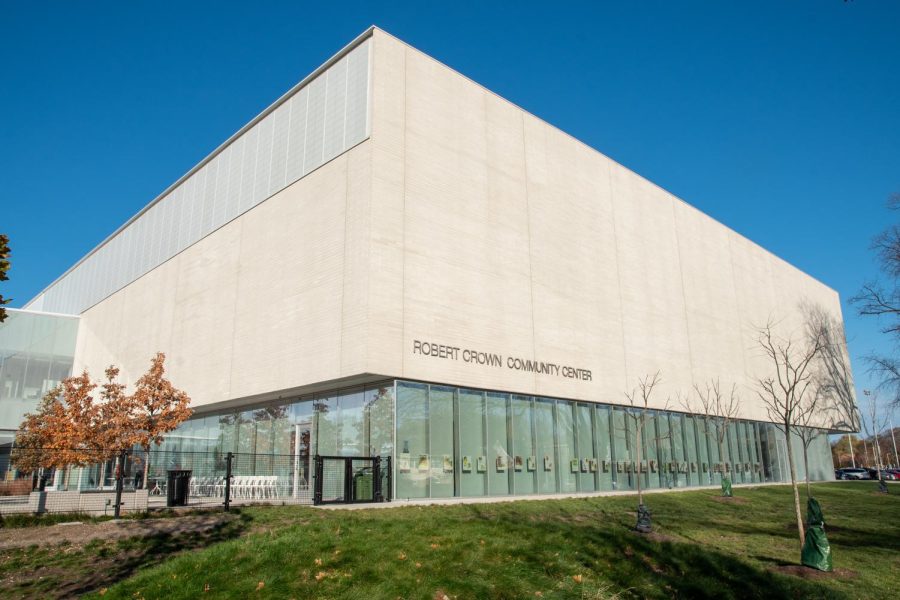Robert Crown Community Center receives LEED sustainability certification, officials reflect on impact
Daily file photo by Madison Smith
Community Partners for Affordable Housing held an information session to explain how to apply for new housing opportunities Tuesday.
May 19, 2022
Rebuilt in 2020, the Robert Crown Community Center is Evanston’s main community center and athletic facility, featuring ice rinks, a preschool and a library. Yet for Andy Tinucci, the principal at Woodhouse Tinucci Architects, which helped design the new building, the facility is more than a hub for activities — it’s a highlight of the community’s commitment to sustainability.
“Almost every resident of Evanston, whether you’ve lived there 50 years or lived there five months, has some story or interaction with the Crown Center,” he said. “It wasn’t just a recreation center. It wasn’t just a conventional sports complex.”
Tinucci is not alone in recognizing Robert Crown’s significance. The building received its LEED certification from the U.S. Green Building Council in April.
LEED is a third-party certification program that sets a sustainable design standard for buildings around the world. Robert Crown’s LEED silver certification places it under the second of LEED’s four levels — certified, silver, gold and platinum.
After nearly 20 years of renovation discussions and months of community debate over the Crown Center’s budget, designers and officials said their investment is starting to pay off.
Climate-centered technologies
Just months after plans to rebuild the community center were approved by City Council in 2018, Evanston enacted its Climate Action and Resilience Plan – a broad policy framework, aims to promote sustainable development and push Evanston to reach net zero carbon emissions by 2050.
According to City Engineer Lara Biggs, the city’s building code calls for new buildings to either meet the LEED silver certification standard or fulfill a number of smaller sustainability requirements. With new climate policies on the table, Biggs said the city wanted to hold themselves to the same standard as other developers.
“What the city decided is that we wanted to be a model,” Biggs said. “If we want developers to produce LEED silver buildings, which we do, then the city needed to step up and produce a LEED silver building.”
Meeting these standards, however, was not an easy task, she said. Because ice rinks require a lot of energy to keep cool, Tinucci said the firm needed to get creative to keep the building energy-efficient while operating the rink.
Brian Foote, project manager for Robert Crown’s redesign and Woodhouse Tinucci senior associate, said the facility extracts heat from water in order to create ice for the rinks. This extracted heat was channeled into creating heated bleacher seats for spectators without increasing the energy cost.
The roofs of the ice rinks are also designed to hold solar panels, which Foote said could offset 5% of the building’s energy costs if the city installs them. In the future, Biggs said the city plans to hire an outside firm to install and manage the potential panels.
Robert Crown’s sports fields include a stormwater detention system underneath, Foote said. This means that rainwater from the facility is stored underground to prevent it from damaging surrounding buildings as runoff.
Though citizens identified stormwater control as an area where the budget could be cut in community feedback sessions, Biggs emphasized that abiding by local laws for stormwater detention is crucial — especially in a lakefront city with a history of flooding issues.
“We didn’t want to not build a relief overflow system, and then create a situation where it would just turn around and run out of capacity as the community continued to build additional buildings that didn’t necessarily control their stormwater,” she said.
A community focus
Tailoring the new space to what Evanston residents wanted was also a priority for designers. Architects engaged residents who lived around the center in over 20 community feedback meetings throughout the construction process, according to Tinucci.
In keeping with the overall mission of the building design, Amilcar Perez, the supervising librarian for the Robert Crown branch of Evanston Public Library, said the new branch location is also focused on sustainable programming, hosting a range of events open to residents.
Having a convenient location with so many other city facilities, he said, has really helped and motivated the new branch to build up its programs.
“It’s the immediacy, the urgency (of the climate crisis), but also the visibility in our location, both in hosting the programs and being able to reach other organizations around town,” he said.
Robert Crown is also home to a Creative Play Preschool and after school programs for children up to 12 years old, which Biggs said benefit from having access to the center’s library and recreation spaces.
As the city continues to pursue climate action and address debt undertaken during Robert Crown’s development, keeping up with community engagement is important, she said.
“This kind of public process involves a lot of stakeholders, and can get very messy sometimes in its discussion,” Biggs said. “But in the long run, we are able to create a facility that’s truly of value to the community.”
Email: lilycarey2025@u.northwestern.edu
Twitter: @lilylcarey
Related Stories:
— Robert Crown Library hosts workshop on talking to children about climate change



